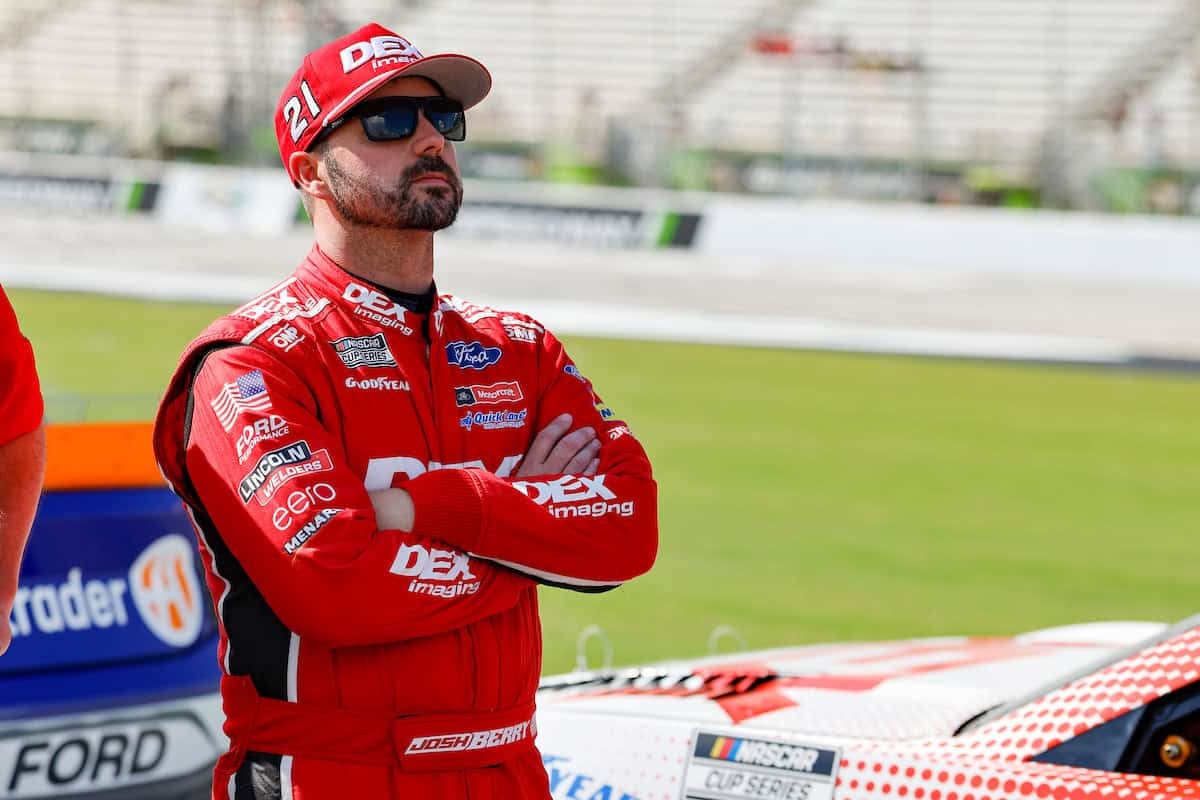A new addition for NASCAR’s top three series in 2025, the Xfinity Fastest Lap program awards one bonus point to the driver that posts the fastest single lap of a race.
In recent months, the bonus point has frequently been won by a wrecked or damaged car that went to the garage and returned to the race.
Kyle Larson set the fastest lap at Mexico City and Watkins Glen International this summer after returning to the track from crash damage and brake issues, respectively.
Southern 500 last-place finisher Josh Berry, who spent more than 100 laps in the garage after a lap 1 crash, posted a fast lap of 169.3 mph after returning to the track.
Berry’s lap was more than two miles per hour faster than the second-fastest lap of 167.1 mph, set by race winner Chase Briscoe.
The teams in the garage are presumably experimenting with a qualifying setup to maximize one-lap pace and secure the bonus point, which is a resource that isn’t available to the drivers and teams in contention for the win.
Mike Forde, NASCAR’s Managing Director of Racing Communications, revealed in this week’s episode of Hauler Talk that NASCAR has contemplated making only lead-lap cars eligible for the point. That idea is purely in the discussion phase, and any changes to the rule wouldn’t take effect until the 2026 season.
Should the Xfinity Fastest Lap point remain available to the entire field and give teams that spent time in the garage something extra to race for? Or is a driver setting the fastest lap after an extended stay in the garage an exploit that needs to be fixed?
Drivers Who Return From Garage Should Be Ineligible
When Larson scored the fastest lap at Mexico City after extended repairs, it was viewed as a brilliant way to salvage a lost day.
Now that multiple drivers and teams have done it across multiple series this summer, it’s clear that being tens or hundreds of laps down is a loophole that gives teams free reign to experiment with posting the fastest lap possible.
By the letter of the law, they’re still the fastest laps. But they’re the fastest laps set in a glorified qualifying session and not a race. Awarding the driver with the fastest lap set in racing conditions was most likely the idea behind adding this rule in the first place.
That said, I don’t agree with restricting the point to lead-lap finishers. If a driver is dominating the race and sets the fastest lap only to crash or blow an engine, they shouldn’t lose the point because of an incident later in the race. Nor should a driver be ineligible from earning the point if they’re trapped a lap down because of an unscheduled pit stop or similar misfortune.
To rectify the situation, drivers should only be ineligible for the point after returning from the garage. A driver that returns from the garage can still earn the point, but only the laps they ran before entering the garage will count. That would keep the entire field eligible for the point while preventing teams from taking advantage of the rule by running experimental or qualifying setups to earn it.
With all that said, if awarding the fastest lap point to a driver that didn’t set the fastest lap is too convoluted, confusing or against the nature of the rule, there’s a simple fix: award the Xfinity Fastest Lap point to the driver that wins the pole.
Qualifying is the site of the fastest laps turned all weekend, and it is the one place where the field is unequivocally on equal footing to post the fastest time on the stopwatch. – Stephen Stumpf
All Cars Should Be Eligible No Matter What
If if ain’t broke, don’t fix it.
And for goodness’ sake, if it works, don’t break it.
NASCAR added a bonus point for the driver with the fastest lap of each race this year, no doubt to give drivers more incentive to race hard throughout an event. It also creates an interesting footnote to some races as the winner of the single point is not always the driver you’d expect.
Sometimes, it’s even a driver who had issues in a race, who comes back from an incident or mechanical issue to lay down a great lap.
That’s something the sport needs. Now, NASCAR is considering a change in the offseason that would limit the bonus to lead lap cars only. In other words, the same old, same old. The argument is that teams can put what’s basically a qualifying setup under a car when they go to the garage for repairs and then turn a fast lap.
Berry did just that last Sunday after a lap 2 crash in the Southern 500 left him multiple laps down for repairs.
Some will say the incentive encourages teams to go back on track when they should retire. But the current rules give them one chance to make minimum speed. They aren’t going to jeopardize that to attempt a lap the car can’t make. And they’re going to try and get back on track anyway, to salvage as many points as they can.
Let’s look at Berry’s situation. You can debate whether he should be, but he’s in the playoffs, and with his early incident coupled with a low seed to begin with, he’s facing elimination.
He and his team did all they could to salvage their race and to take everything available to them.
They did that.
If Berry, or another driver in the same situation, avoids playoff elimination by a single point, that should be applauded. Qualifying setup or no, repairing a damaged car to not only make minimum speed but to surpass the entire field’s best attempt is a solid accomplishment.
If nothing else, if the driver who takes the bonus is unexpected or overcame an issue, it gives that driver’s fans something to cheer for. NASCAR created something for teams to work toward, and if they overcome a major obstacle like crash damage to do it, they’re doing what every team should be doing all race, every race: trying to maximize performance for the best points outcome possible, even if the win is out of reach.
That’s what NASCAR is supposed to be about. Literally, the entire point of the sport is for drivers to get the most out of their cars. Why would NASCAR want to stop anyone from doing that?
Or worse, why would they want to reward someone for being second best? The fastest lap bonus is fine as it is. It’s making teams work harder on repairs to make sure their cars not only meet minimum standards but are good enough to return an make a statement. It give fans something to follow and cheer for. And the day may come when it means the difference between chasing a title or being eliminated.
The only thing NASCAR should do differently for next year is to make the bonus a playoff point.
Other than that, leave it alone. If NASCAR demands teams give a hundred percent during races, then it needs to reward the ones who actually do accordingly. – Amy Henderson
Stephen Stumpf is the NASCAR Content Director for Frontstretch and is a three-year veteran of the site. His weekly column is “Stat Sheet,” and he formerly wrote "4 Burning Questions" for three years. He also writes commentaries, contributes to podcasts, edits articles and is frequently at the track for on-site coverage.
Find Stephen on Twitter @stephen_stumpf
Amy is an 20-year veteran NASCAR writer and a six-time National Motorsports Press Association (NMPA) writing award winner, including first place awards for both columns and race coverage. As well as serving as Photo Editor, Amy writes The Big 6 (Mondays) after every NASCAR Cup Series race. She can also be found working on her bi-weekly columns Holding A Pretty Wheel (Tuesdays) and Only Yesterday (Wednesdays). A New Hampshire native whose heart is in North Carolina, Amy’s work credits have extended everywhere from driver Kenny Wallace’s website to Athlon Sports. She can also be heard weekly as a panelist on the Hard Left Turn podcast that can be found on AccessWDUN.com's Around the Track page.








